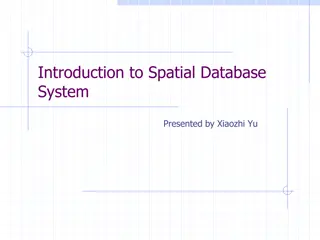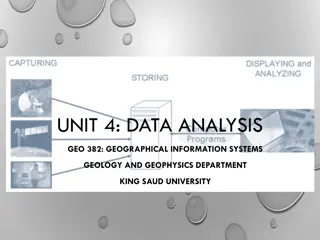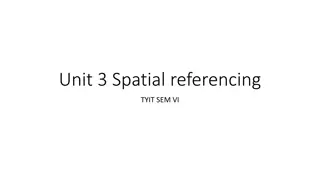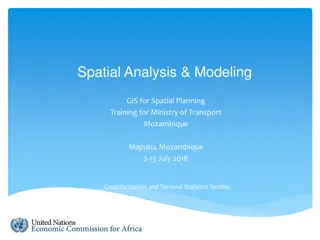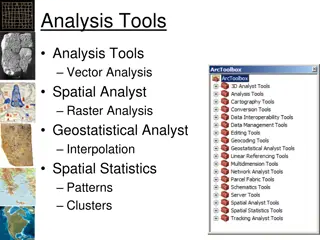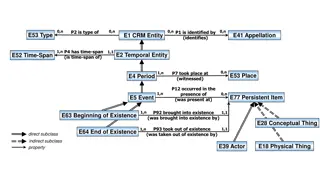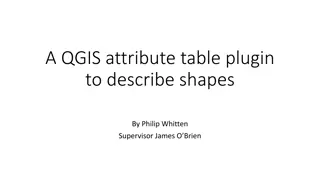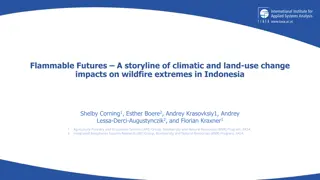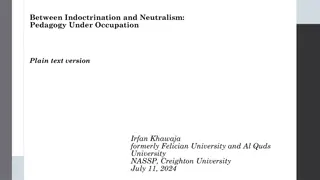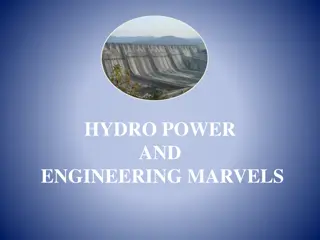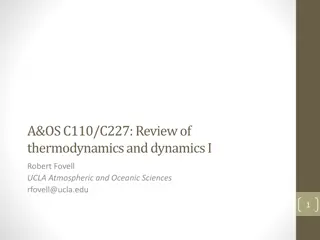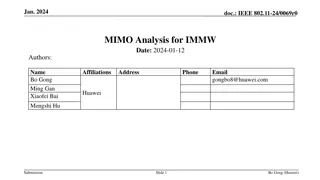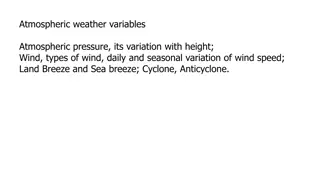Understanding Spatial Extremes: Complex Time Methods in Hydro-Atmospheric Dynamics
This study explores the use of complex time methods and chameleon scalar fields in understanding and modeling spatial extremes in hydrological and atmospheric systems. By transforming Lagrangian processes and introducing chameleon scalar fields, the research unveils new insights into the mechanism governing spatial extremes and causal relationships between different objects. The model utilizes a complex non-Euclidean structure and analyzes the interaction triplet of ground regions, atmosphere, and hydrology on a complex statistical manifold. Through a modified tessellated form, the model's results can be reduced to Euclidean space, revealing additional properties of the main actor quantities.
- Spatial Extremes
- Complex Time Methods
- Hydro-Atmosphere Dynamics
- Chameleon Scalar Fields
- Statistical Manifold
Download Presentation

Please find below an Image/Link to download the presentation.
The content on the website is provided AS IS for your information and personal use only. It may not be sold, licensed, or shared on other websites without obtaining consent from the author. Download presentation by click this link. If you encounter any issues during the download, it is possible that the publisher has removed the file from their server.
E N D
Presentation Transcript
National Technical University of Athens, Greece Session HS7.10/NH1: Spatial extremes in the hydro-and atmosphere: understanding and modelling: Complex Time Methods and Chameleon Scalar Fields in the Dynamics of Spatial Extremes Dionysia Panagoulia* and Kalomoira Zisopoulou** *School of Civil Engineering, Department of Water Resources and Environmental Engineering, National Technical University of Athens, Zografou, Greece e-mail: dpanag@hydro.ntua.gr **Travaux Publics, Becket House, London, United Kingdom
Abstract It is shown that complex time in classical physics may transform the action functional Lagrangian and Lagrangian density processes to, among others, energy descriptive functionals. By imposing restrictions in the problem coordinate space as per need, such as Sobolev or Hardy spaces, or to the complex time plane such as the two variable Hilbert Space dependent Bergman Decomposition new results are obtained which facilitate a better understanding of the mechanism governing spatial extremes in terms of flows. The introduction of Khoury-Weltman type chameleon scalar fields will, by the recognition of existing oscillatory patterns, pave a connective chain of momenta between smaller and larger objects which will uncover the causal relationships between them which will allow for variable reduction in multivariate methods.
General Layout The layout follows the classical structure of modelling practice. The main difference with previous models is that, while data are real time data bundles corresponding to standard dynamics in Euclidean space (Cooley et al.,2012), the Model is a complex time non-Euclidean structure with different dynamics. Also Ground Data are introduced in a modified tessellated form and include the target region as a subset. Model results are reducible to Euclidean space and additional properties of the main actor quantities are revealed.
The Model analyzes the phenomena interaction triplet (ground region, atmospheric, hydro) The Model is an L-dimensional complex generalized statistical manifold (Lauritzen 1987;Noguchi 1992;Van L 2006;Matsuzoe, Takeuchi, and Amari 2006;Mike and Stepanova 2014;Matsuzoe Yuan 2019) which has Hausdorff properties ensuring that no apparition points exist (Kent, Mimna, and Tartir 2009). It is endowed with a topology (Belavkin 2016;Wasserman 2018) and a measure induced by a complex Riemannian metric (Ganchev and Ivanov 1991;Pennec 2006) while time is a complex quantity ? ?=? ?+? ?? ?. The manifold may be analyzed into a finite number N of non- intersecting patches (Recami and Tahir Shah 1979) constituting a complete covering which, among other properties, play the role of points in a common statistical manifold. To every patch there corresponds a multivariate system of complex stochastic equations of processes (Ma, Protter, and Yong 1994;Abraham and Riviere 2006;Lin, Sun, and Wang 2008;Carmona and Delarue 2013;Belopolskaya 2013;Carmona and Delarue 2015;Ji, Liu, and Xiao 2016;Dahl 2020) with increments of variable endogenous/exogenous dependency and an added coupling factor function which interconnects them to neighboring patches allowing the use of a generalized form of Girsanov s Theorem (Revuz and Yor 1991). Modified Chameleon theory is employed (Khoury and Weltman 2004a;Khoury and Weltman 2004b;Robertson 2008;Robertson 2009). Each patch includes a border submanifold of extremal entry points and extremal exit points of variable codimension, the points belonging to the incoming and outgoing phenomena and are reversely connected with neighboring patches. A controlling process within the target region, based on relativistic-like cut-offs, determines the state of extremity of the phenomena with values defined within ranges allowing for the building of a manifold of extremities with definite hierarchy of intensity.
Bibliograph y Abraham, Romain, and Olivier Riviere. 2006. Forward-Backward Stochastic Differential Equations and PDE with Gradient Dependent Second Order Coefficients. ESAIM: Probability and Statistics 10: 184 205. https://doi.org/10.1051/ps. Belavkin, Roman V. 2016. Asymmetric Topologies on Statistical Manifolds . In Geometric Science of Information. GSI 2015. Lecture Notes in Computer Science, Vol 9389, edited by F. Nielsen and F. Barbaresco, 203 10. Springer. Belopolskaya, Ya. I. 2013. Forward-Backward Stochastic Differential Equations Associated with Systems of Quasilinear Parabolic Equations and Comparison Theorems. Zap. Nauchn. Sem. POMI 412: 15 46. Carmona, Ren , and Francois Delarue. 2013. Mean Field Forward-Backward Stochastic Differential Equations. Electronic Communications in Probability 18 (68): 1 15. https://doi.org/10.1214/ECP.v18-2446. Carmona, Ren , and Fran ois Delarue. 2015. Forward-Backward Stochastic Differential Equations and Controlled Mckean-Vlasov Dynamics. Annals of Probability 43 (5): 2647 2700. https://doi.org/10.1214/14-AOP946. Cooley, Daniel, Jessi Cisewski, Robert J. Erhardt, Soyoung Jeon, Elizabeth Mannshardt, Bernard Oguna Omolo, and Ying Sun. 2012. A Survey of Spatial Extremes: Measuring Spatial Dependence and Modeling Spatial Effects. Revstat Statistical Journal 10 (1): 135 65.
Dahl, Kristina Rognlien. 2020. Forward-Backward Stochastic Differential Equation Games with Delay and Noisy Memory. Stochastic Analysis and Applications 0 (0): 1 22. https://doi.org/10.1080/07362994.2020.1713810. Ganchev, Georgi and Stefan Ivanov. 1991. Connections and Curvatures on Complex Riemannian Manifolds. Ji, Shaolin, Haodong Liu and Xinling Xiao. 2016. Fully Coupled Forward-Backward Stochastic Differential Equations on Markov Chains. Advances in Difference Equations 2016 (1): 1 18. https://doi.org/10.1186/s13662-016-0859-6. Kent, Steven L., Roy A. Mimna and Jamal K. Tartir. 2009. A Note on Topological Properties of Non-Hausdorff Manifolds. International Journal of Mathematics and Mathematical Sciences 2009. https://doi.org/10.1155/2009/891785. Khoury, Justin and Amanda Weltman. 2004a. Chameleon Cosmology. Physical Review D - Particles, Fields, Gravitation and Cosmology 69 (4). https://doi.org/10.1103/PhysRevD.69.044026. . 2004b. Chameleon Fields: Awaiting Surprises for Tests of Gravity in Space. Physical Review Letters 93 (17): 1 4. https://doi.org/10.1103/PhysRevLett.93.171104.
Lauritzen, Steffen L. 1987. Statistical Manifolds. In Differential Geometry in Statistical Inference (IMS Lecture Notes--Monograph Series, Volume 10), edited by Shanti S. Gupta, 165 215. Inst. of Mathematical Statistic. https://doi.org/10.1201/9781315141268-3. L , H ng Van. 2006. Statistical Manifolds Are Statistical Models. Journal of Geometry 84 (1 2): 83 93. https://doi.org/10.1007/s00022- 005-0030-0. Lin, Xiang Yun, Qiu Xia Sun, and Xiang Rong Wang. 2008. The Robustness of Fully Coupled Forward-Backward Stochastic Differential Equations. Journal of Physics: Conference Series 96 (1): 1.6. https://doi.org/10.1088/1742-6596/96/1/012207. Ma, Jin, Philip Protter, and Jiongmin Yong. 1994. Solving Forward-Backward Stochastic Differential Equations Explicitly - a Four Step Scheme. Probability Theory and Related Fields 98 (3): 339 59. https://doi.org/10.1007/BF01192258. Matsuzoe, Hiroshi. 2015. Complex Statistical Manifolds and Complex Immersions. In Current Developments in Differential Geometry and Its Related Fields - Proceedings of the 4th International Colloquium on Differential Geometry and Its Related Fields, edited by Toshiaki Adachi, 1rst ed., 256. World Scientific. Matsuzoe, Hiroshi, Jun ichi Takeuchi, and Shun ichi Amari. 2006. Equiaffine Structures on Statistical Manifolds and Bayesian Statistics. Differential Geometry and Its Application 24 (6): 567 78. https://doi.org/10.1016/j.difgeo.2006.02.003
Mike, Josef, and Elena Stepanova. 2014. A Five-Dimensional Riemannian Manifold with an Irreducible SO(3)-Structure as a Model of Abstract Statistical Manifold. Annals of Global Analysis and Geometry 45 (2): 111 28. https://doi.org/10.1007/s10455-013-9390-0. Noguchi, Mitsunori. 1992. Geometry of Statistical Manifolds. Differential Geometry and Its Applications 2 (3): 197 222. https://doi.org/10.1016/0926-2245(92)90011-B. Pardoux, Etienne and Shanjian Tang. 1999. Forward-Backward Stochastic Differential Equations and Quasilinear Parabolic PDEs. Probability Theory and Related Fields 114 (2): 123 50. https://doi.org/10.1007/s004409970001. Pennec, Xavier. 2006. Intrinsic Statistics on Riemannian Manifolds : Basic Tools for Geometric Measurements. Journal of Mathematical Imaging and Vision 25 (1): 127 54. Recami, E., and K. Tahir Shah. 1979. A Multiply-Connected Space-Time, Black Holes, and Tachyons. LETTERE AL NUOVO CIMENTO 24 (24): 5 9. Revuz, D., and M. Yor. 1991. Girsanov s Theorem and First Applications. In Continuous Martingales and Brownian Motion, Grundlehren Der Mathematischen Wissenschaften Vol 293, 301 37. Springer.
Robertson, Glen A. 2008. Application of the Chameleon Model to EM Field Momentum. AIP Conference Proceedings 969 (January): 1063 69. https://doi.org/10.1063/1.2844944. . 2009. Engineering Dynamics of a Scalar Universe Part I: Theory & Static Density Models. AIP Conference Proceedings 1103 (March): 687 705. https://doi.org/10.1063/1.3115579. Wasserman, Larry. 2018. Topological Data Analysis. Annual Review Of Statistics and Its Application, no. 5: 501 32. Yuan, Mingao. 2019. On the Geometric Structure of Some Statistical Manifolds. Balkan Journal of Geometry and Its Applications 24 (2): 79 89.





